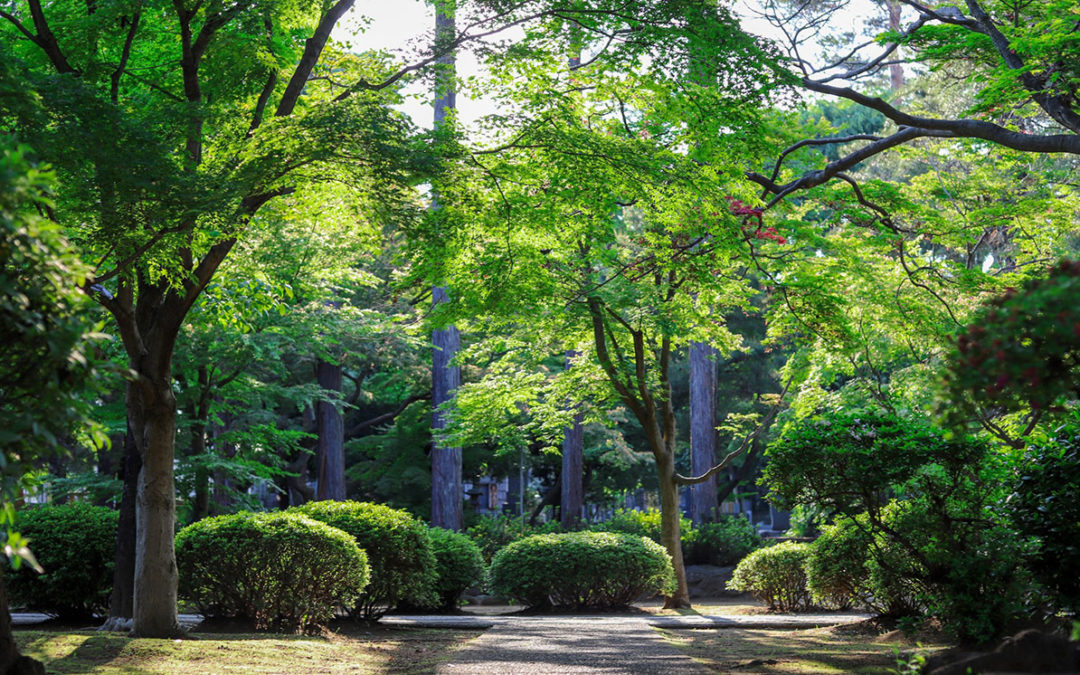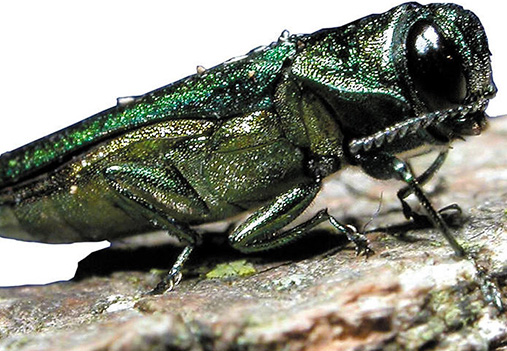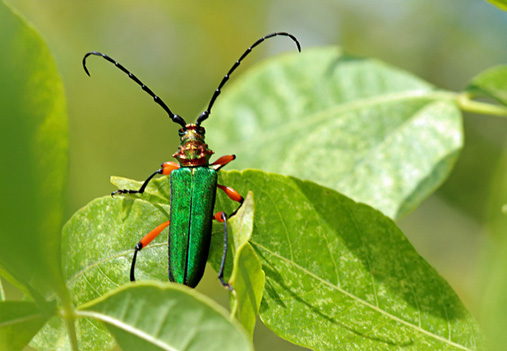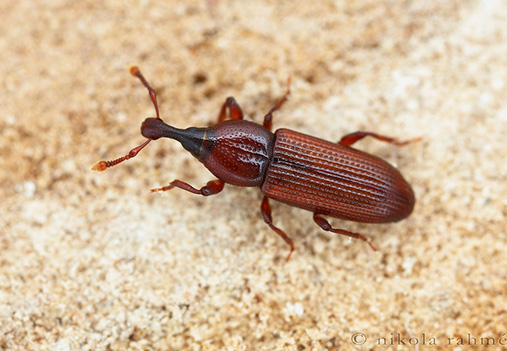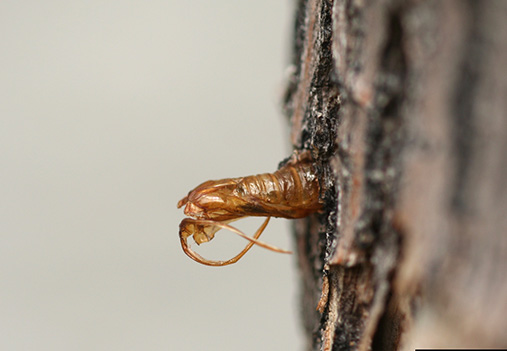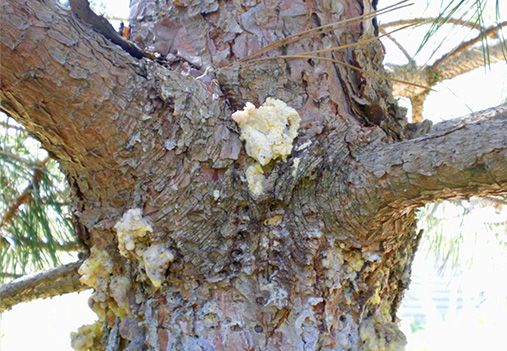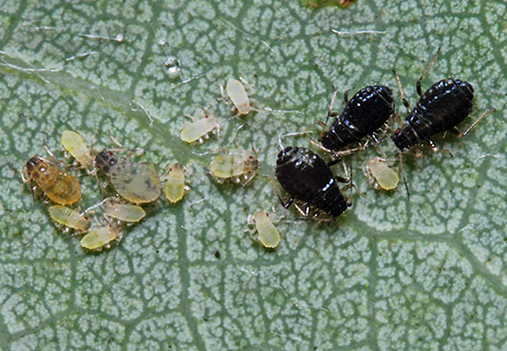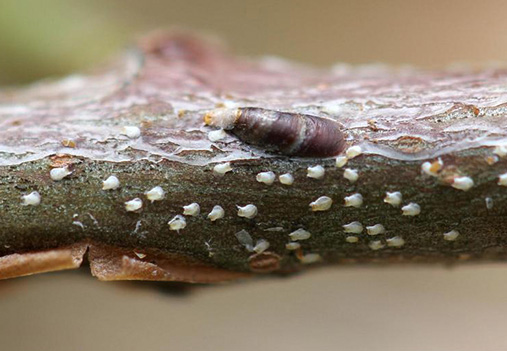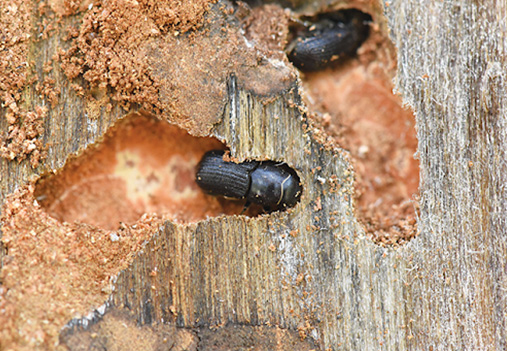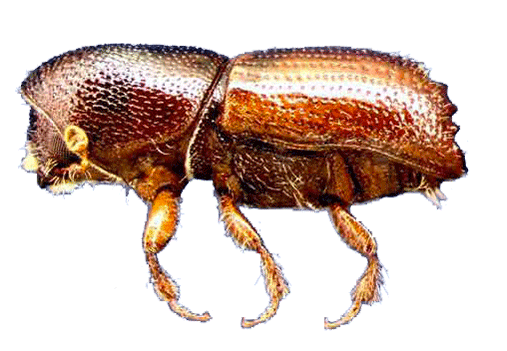Systemic Tree Injections
Ross Tree, a leading innovator in tree insect control, recommends tree systemic injections to control tree insects. We were the first tree company in Denver to offer tree injections, a practicable alternative to spraying trees. Using systemics ensures that only the tree gets the product, not the surrounding environment.
Healthy Trees Fend Off Tree Insects
Well-watered, fertilized, and pruned trees tend to be healthy, and they can fend off attacks by most pests, besides the Emerald Ash Borer (EAB). For example, well-hydrated Conifers drown invading insects with their sap. Tree pruning removes damaged branches and opens the tree for healthy canopy development. Trees produce defensive chemicals in response to insect wounding that may weaken and kill the invading insects. All high-value Ash trees in the Denver area need systemic protection in 2021 because they have zero immunity to the EAB.
How A Systemic Insecticide Works
Systemic products use the tree’s root and vascular system to distribute the chemicals to every single leaf and twig, protecting the plant from the inside out. Systemics work great on tall trees at a fraction of the price of getting the foliage sprayed by a tree service company. Government agencies regulate some systemic compounds. Only applicators licensed by the Agriculture Department of the State of Colorado can buy these products.
Once inside the tree, the formulations protect it from future attacks. It is important to note that these products do not keep tree pests from landing on a tree and feeding. But once the adults or larvae eat the tree’s leaves or internal tissues, they eventually die. Soil-applied products take about two weeks to become effective, while bole sprayed and trunk injected products protect the tree more quickly.
Soil-applied Systemic Products
Soil-applied systemics control Elm leaf pests, Aphids, Scales, Mites, and Wood Borers well. It takes several weeks for the product to be taken up by the tree’s root system in sufficient concentrations to control these insects. The best application time is when the fully grown insects become active and begin to lay eggs. The soil must be kept moist enough for the product to move to the roots. Applicators must follow the product label instructions closely to protect bee populations. Soil applied-systemic are marginally effective in controlling the EAB.
Trunk Sprayed Systemic Products
A tree’s bark is the hard, protective tissue, which acts as a defense against pests, fire, physical damage, and the sun. Interspersed throughout the bark are tiny pores called lenticels, which allow the interchange of gases between the atmosphere and the woody plants’ internal tissues. Trunk spraying delivers systemics through these holes to the vascular system of the tree. It takes about a week for trunk sprayed systemics to start to work. Research shows that these products do control the EAB.
Trunk Injected Systemic Products
Trunk injections are a good choice when the site conditions prevent the use of sprayed or soil-applied products. Trunk injections require specialized equipment, the knowledge to determine the correct dosage, and the ability to precisely follow the instructions on product containers. Some controlled systemics require the applicator to be licensed and be on-site when injecting trees. Trunk injections are more expensive than other systemic application methods, but they provide reliable insect control for at least two years. It is worthwhile to discuss tree anatomy to understand how systemic trunk injections work.
Tree Anatomy
The target for trunk injection is the Xylem of the tree trunk. Xylem tissue consists of water-conducting cells known as tracheary elements. The Xylem conveys water and dissolved minerals from the roots to the rest of the plant. Once injected into Xylem, the control compounds hitchhike a ride and are distributed to all parts of the plant, protecting the tree from insect pests.
What are the Benefits of Systemic Injection of Trees?
The characteristics listed below make trunk injections the best approach for insect control for trees near waterways, pools, campuses, and public areas. Since universities and hospitals usually do not close, systemic trunk injections keep the public safe.
- Chemical Trapped in Tree
Injected insect control product stays in the tree.
- Environmentally Safe
Product containment minimizes exposure to soil, water, and air.
- Limited Exposure
Product containment minimizes public and applicator exposure.
- Better Efficacy
Injected control products are more effective, with no photo or microbial degradation.
- Targeted Control
Systemic injections only kill the insects feeding on treated trees.
- Wider Treatment Windows
Injected formulations control tree pests for up to two years, expanding the window of treatment.
The Systemic Injection Process
A tree company, well versed in tree injection treatment, will take the following steps to ensure a good result.
- Measure & Identification – The first step is for an arborist to identify what insect is attacking the tree. Next is measuring the tree. Tree size determines the number of injection sites and the amount of product needed to control the problem.
- Drill – Drill holes into the bottom 18 inches of the tree. Buttress roots or root flares are ideal locations. Sterilize drill bits between applications.
- Plugs – Plastic oneway ports trap the control products inside the tree, so no chemicals drip into the surrounding environment. The use of plugs reduces the chance of vector disease contamination. In time, the tree heals, covering the plug wounds.
- Inject – The control product is either injected with or without pressure. The approach depends on the size of the tree. Large trees require pressurized treatments injected into multiple holes evenly distributed around the tree.
- Watering – After the injection process is complete, the tree needs watering. The water moves the control product up the Xylem, setting the trees up for success.
Tree and Site Considerations
The systemic insecticide may come as a dry powder or a liquid. Both are mixed with water to form the right concentration based on tree size. The best results for systemic treatments occur when the trees are:
- Actively Growing – Growing trees take up water and move injected control compounds better. We recommend fall applications only when leaves are still on the trees.
- Healthy – Hardy trees take up control products more actively. Treating stressed or diseased trees is less effective.
- Non-saturated Soils – If the trees are not thirsty, the roots do not transport the control product.
- Dry Soils – The lack of water hinders the vascular system’s ability to distribute the control product.
- Apply During a Sunny, Warm Week – After application, warm weather forces the tree to expire water triggering the root system and vascular system to transport the product throughout the tree.
- Frozen Ground – Treating trees after the ground freezes is a waste of time and money.
Tree Pests Controlled by Systemics
Most tree insect treatments work best when the adult insects become active in the spring and start laying eggs. Once injected and absorbed by the tree, systemics take the guesswork out of tree insect control and creates a larger treatment window. However, the timing of the first application is crucial to protect the tree during the first year.
Elm Leaf Pests
Elms growing in Denver need extra care. Spraying in the summer to control Elm leaf pests is an option, but showering large Elm trees, whose canopies spread over houses, streets, and playgrounds, causes wasteful product drift. It is best to use systemic products instead. We recommend using systemics to control the following insects in Denver. Three are beetles, and one is a sawfly.
- Elm Leaf Beetle
- Elm Leaf Miner
- European Elm Flea Weevil
- Japanese Beetles
Once injected into the soil, the roots take up the solution, where it stays active for a year. When present in the leaf tissue, it kills any larvae or adults feeding on the tree. We recommend trunk injections for trees located in public areas or small yards. For more information, go to Ross Tree’s “Handbook on Elm Leaf Pests.”
Shade Tree Borer Control
Colorado’s most common wood borers are the Peachtree, Lilac, Emerald Ash Borers, and the Zimmerman Pine Moth. After hatching, the larvae tunnel into the branches, trunks, or roots of trees. Their larvae mine through the tree’s Cambium, Phloem, and Xylem layers, hindering the tree’s ability to feed itself. Without treatment, these insects cause dieback, canopy thinning, and, sometimes, death.
Metallic Wood Borers
Colorado is home to 92 flathead borers that feed on various fruit, Ash, Willow, Birch, Cottonwoods, and Locusts trees. The most destructive Metallic Wood Borer, the Emerald Ash Borer (EAB), kills Ash trees. The insect came to Colorado in 2013 and is now spreading along the Front Range, putting all Ash trees at risk. The potential impact of the EAB is enormous since 15 percent of the urban forest in the Denver metropolitan area is Ash. For more information about Denver’s EAB effort, please check out the Be a Smart Ash website.
It is the beetle’s grubs that do the majority of the damage. Their larvae mine the transport tissues for one or two years, restricting the plant’s movement of nutrients. As the adults emerge, they chew a distinctive D-shaped exit hole. For the last eight years, Front Range cities have been thinning out marginal Ash trees. They use systemic trunk spraying and injections to save high-value trees because Ash have no immunity to the EAB.
Longhorned Beetles
Longhorned Beetles attack Maple, Birch, Horse Chestnut, Poplar, Willow, Elm, Locust, and Ash trees growing in Denver. Common infestation signs include yellowing leaves, oozing sap, and finding coarse sawdust on the trunks. These beetles have round-headed grubs. The brown, gray, and bright patterning adults are medium-sized with long antennas that look like horns. Adult beetles chew a small pit into the bark to lay eggs. After hatching, the larvae feed on the Cambium but sometimes bore deeper, causing significant structural weakening. It takes one to two years for the adults to emerge chewing an oval-shaped exit hole. Poplar and Locust Borers can cause substantial damage to healthy trees in Denver.
Wood Borer Weevils
The Poplar and Willow Borer Weevils are the most common members of this insect family found in Colorado. These borers attack young trees 1 to 4 inches in diameter. The adults emerge from exit holes plugged with sawdust mixed with excrement.
Clearwing Borers
The Lilac/Ash and Peachtree Borers are found in Denver and can seriously damage mature trees. Adults Clearwing Borers are moths with transparent wings. Since they look like wasps, birds avoid them even though they are harmless. Their larvae have five pairs of prolegs on the abdomen’s underside, each marked with a series of hooks or crochets. As they feed, the larvae make large wounds under the bark. When full-grown, they excavate an area just underneath the bark and transition to the pupal stage. When they emerge in the spring, the adults push through the bark. Before they fly away, the insects pull the pupal case through the opening marking its exit from the tree.
Pyralid Borers
In Colorado, the Pyralidae family includes the Pinyon Pitch Mass Borer and the Zimmerman Pine Moth. Their larvae develop in the trunks or branches of pine trees, chewing large lesions under the bark. Affected trees produce copious amounts of sap to cover the injuries. The larvae possess five pairs of short prolegs on the abdomen, each tipped with a circle of fine crochets.
Systemic Treatment of Wood Tree Borers
Once the wood borers larvae enter a tree, spraying becomes ineffective. So the best approach to controlling these insects is with systemic compounds. Whether to use soil-applied, bole sprays, or trunk injections depends on the type of borer, the tree’s location, and size. Soil applied systemics control most Metallic Wood Borers. Soil-applied products are not effective against Clearwing and Pyralid Borers whose larvae spend much of the time deep into the tree’s interior. Trunk sprayed systemics are effective against Metallic Wood Borers and Longhorn Beetles. They are also effective in curbing the EAB and all the insects discussed in this blog. Since systemic control products require considerable expertise, we recommended homeowners hire a licensed pesticide applicator licensed by the State of Colorado for the job.
Other Tree Pests Treated with Systemics
Aphids
Aphids are the most common insect in Colorado. Some species are significant pests, reducing plant vigor, producing leaf curl, and secreting large amounts of honeydew, which molds adding to the mess. Aspen, Maple, Giant Conifer, and Elm Leaf Aphids are active in Denver. Aphids usually do not kill trees, but they are considered a nuisance. Ladybugs, Lacewings, Syrphid Flies, and Parasitic Wasps keep Aphid populations in check.
However, homeowners dealing with copious amounts of sticky, moldy honeydew covering their patios, furniture, and cars sometimes want relief. They hire tree service companies to apply dormant oil in the winter or inject their trees in the early spring to control Aphids. Homeowners with large infestations in the summer will have to resort to spraying, which is not optimal.
Scale Insects
Scale insects suck sap much like Aphids. Oystershell, Pine Needle, San Jose, and other Hard Scales produce waxy covers that protect them from predators and insecticides. Soft Scale control is similar to Aphids and Mealybugs, but these products are not effective against Hard Scales. Since Hard and Soft Scales require different control products, insect identification is essential when deciding treatment options. Applying dormant oils in the winter or using systemic injections in the early spring control both Pine and Hardwood Scales found in the Denver area.
Spider Mites
Spider Mites attack Spruce, Oak, Honeylocust, Blue Spruce, and Arborvitae trees in Denver. Mites are not insects but are closely related to spiders, ticks, and scorpions. Spider Mite populations develop rapidly under dry conditions. Plants under stress are particularly susceptible to mite injury. Trees getting proper watering and fertilization are less vulnerable to damage by this insect. Heavy mite infestations are hard to control even with pesticides, so prevention is the best tact for controlling this Arachnida.
Conifer Mites can do a lot of damage before noticed. If not treated, the Pines start to turn yellow, and their needles drop. Sprays of insecticidal soaps do suppress mite populations, but spraying these products on large trees is problematic. Systemics is a good choice, but their application depends on the extent of tree damage and the mite species.
Pine Beetles
These insects thrive during drought years. The adults emerge in early summer with the females looking for Lodgepole and Ponderosa Pines to lay eggs. After hatching, the larvae tunnel into the tree to feed and to overwinter. The pupal stage ends in late spring. The adults seek new hosts from July through August. Systemic injections are best done in the fall or early spring before the adult beetles become active and fly to other trees.
Ips Beetles
The Ips Beetle is one of the most destructive pests attacking Pine and Spruce trees in Denver. Signs of infestation are sawdust in bark crevices, around entrance holes, and on the ground around the tree’s base. Also, a tree’s foliage progresses from green to yellow, to red to reddish-brown. Systemic trunk injections can protect large, high-value trees. For more information, please check out Ross Tree’s “Evergreen Tree Insects Common to Denver Handbook.”
Why Hire A Professional Tree Service Company?
Homeowners should hire a professional tree service company for three reasons – trees are valuable real estate assets, work in trees is hazardous, and tree health issues can be complex. Sometimes, it takes an expert to spot and identify a tree insect or disease. Determining the breeding cycles of tree pests makes treatment timing difficult, and many of the products used to control these insects require an applicator license from the State of Colorado. Leading tree service companies like Ross Tree have the equipment and trucks to do systemic injections, tree watering, and fertilization professionally and efficiently. Below is a video of a tree injection truck. These trucks allow Ross Tree’s Plant Health Care professionals to bring all the water, control products, hoses, injection equipment to the site in one vehicle.
Looking for a tree company experienced systemic injections? Why no got to the company that pioneered this treatment approach in the Denver area. Ross Tree has three arborists and three Qualified Supervisors licensed by the State of Colorado on staff. Homeowners interested in controlling tree pests with systemic products should call us at 303-871-9121 or click here to fill out a request service form.

